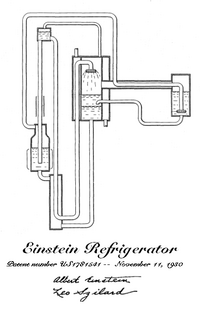Einstein refrigerator

An Einstein refrigerator is a special type of refrigerator that doesn't need any electricity to work. It is named after Albert Einstein, who came up with the idea for it.
So, how does it work? It uses a principle called the "adiabatic cooling" to cool things down. Adiabatic cooling is when you reduce the pressure of something, it gets cooler. This is why compressed air is cold when it comes out of a can of compressed air.
In an Einstein refrigerator, there are two gases - hydrogen and helium. These gases are put in a closed container with a valve between them. When the valve is opened, some hydrogen goes from the high-pressure side to the low-pressure side. This causes it to expand, and as it expands, it gets colder (remember adiabatic cooling!).
This cold hydrogen then comes in contact with whatever needs to be cooled, like food or drinks. It absorbs the heat from the food and drinks, making them colder. Then the hydrogen goes back to the high-pressure side, and the process starts all over again.
So, to sum up - the Einstein refrigerator doesn't need electricity because it uses the principle of adiabatic cooling to cool things down. It has two gases – hydrogen and helium – that undergo cycles of pressurization and depressurization. This constant movement and pressure changes cause a cooling effect. Voila, you have a fridge that keeps your drinks and food cool without any electricity involved!
So, how does it work? It uses a principle called the "adiabatic cooling" to cool things down. Adiabatic cooling is when you reduce the pressure of something, it gets cooler. This is why compressed air is cold when it comes out of a can of compressed air.
In an Einstein refrigerator, there are two gases - hydrogen and helium. These gases are put in a closed container with a valve between them. When the valve is opened, some hydrogen goes from the high-pressure side to the low-pressure side. This causes it to expand, and as it expands, it gets colder (remember adiabatic cooling!).
This cold hydrogen then comes in contact with whatever needs to be cooled, like food or drinks. It absorbs the heat from the food and drinks, making them colder. Then the hydrogen goes back to the high-pressure side, and the process starts all over again.
So, to sum up - the Einstein refrigerator doesn't need electricity because it uses the principle of adiabatic cooling to cool things down. It has two gases – hydrogen and helium – that undergo cycles of pressurization and depressurization. This constant movement and pressure changes cause a cooling effect. Voila, you have a fridge that keeps your drinks and food cool without any electricity involved!
Related topics others have asked about:
